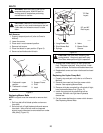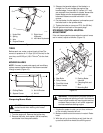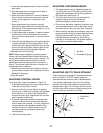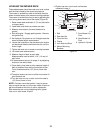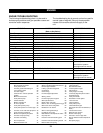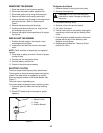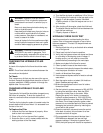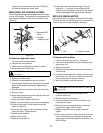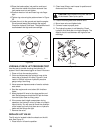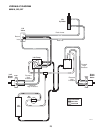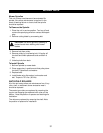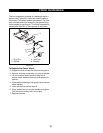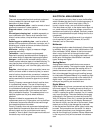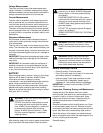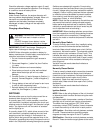
28
13.Place the brake caliper into position and insert
bolts from the inside of the frame outward. Use
lock washer and nut and tighten.
14.Position wheel on hub and insert lug nuts finger
tight.
15.Tighten lug nuts using the pattern shown in Figure
20.
16.Lower the unit to the ground and start the engine.
Drive forward twenty feet and stop the engine.
Check the hydraulic fluid level. The dipstick should
read between the high and low markings.
Figure 20
HYDRAULIC DECK LIFT PRESSURE TEST
Use this test for trouble shooting the hydraulic lift
system if the lift becomes sluggish or loss of lift occurs.
1. Place unit into the service position.
2. Clean and disconnect the hydraulic hose at the
lower side of hydraulic lift valve (Figure 21) and
install a 1500 psi minimum hydraulic pressure
gauge using a tee fitting.
3. Have someone depress center of seat to activate
seat switch.
4. Start the engine and run at about 3/4 throttle or
faster.
5. Move the deck lift lever to the raise position and
hold. Relief pressure should be 650 psi minimum
from the Hydro-Gear auxiliary pump.
6. If the mower deck height creeps down during
operation, the hydraulic valve, cylinder or hydraulic
hose is faulty. You will need to check the condition
of the hoses and verify that there are no hydraulic
leaks and the fittings are tight.
7. Remove the valve.
REPLACE LIFT VALVE
The lift valve is located inside the chassis on the left
side. See Figure 21.
1. Place hood in full service position.
2. Clean hose fittings, mark hoses for position and
disconnect from valve.
3. Loosen mounting bolts and remove valve.
4. Mount new valve and tighten bolts.
5. Connect hoses to proper ports.
6. The hydraulic system is self-bleeding. Check
hydraulic fluid level after running the engine. The
dipstick should read between the high and low
markings.
Figure 21
1
3
2
4
5
OK 0630
CAUTION: Some hydraulic fluid will leak out
of the hoses. Clean up any spills.
Lift Valve



